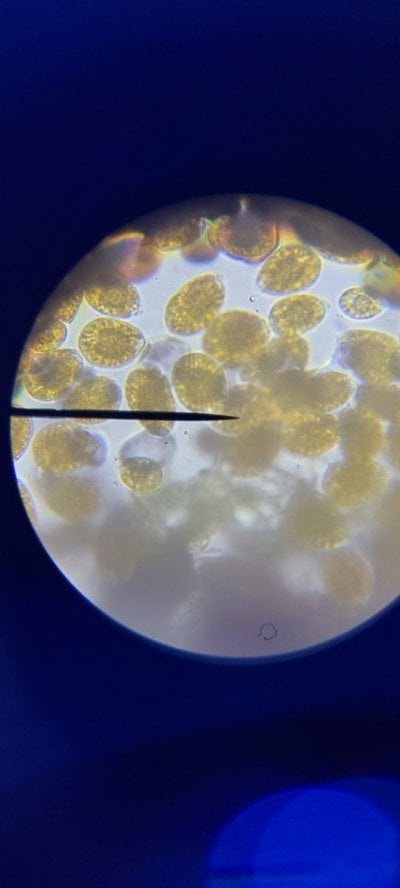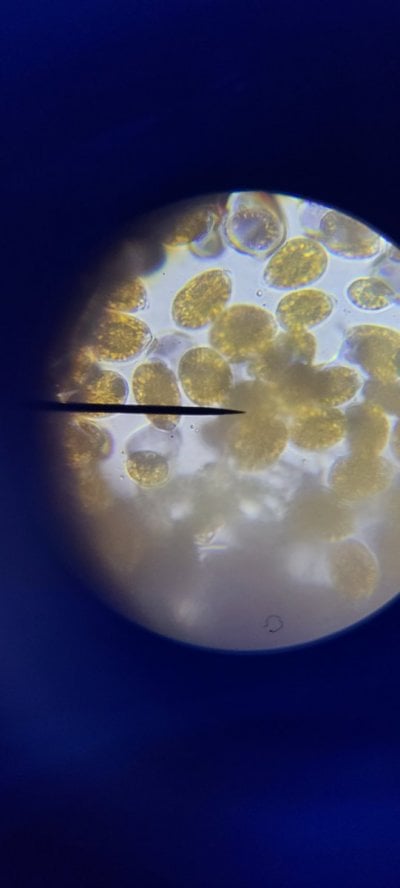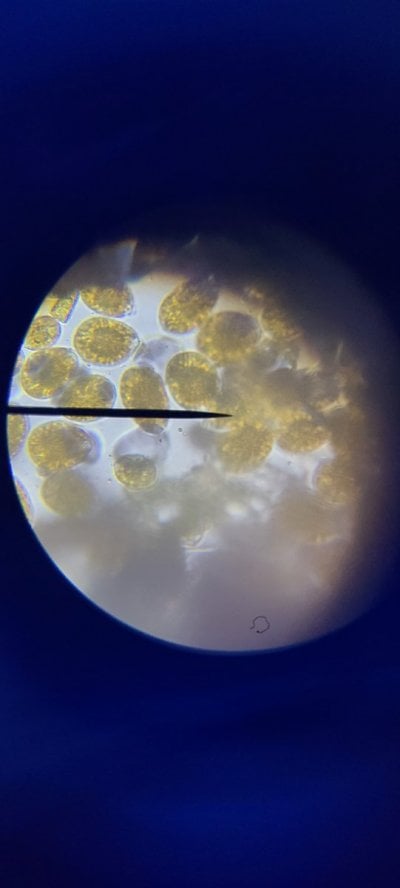Nope. I thought so too. It is something else. It was diatoms, but I have never seen diatoms cover cause this much crazy.Aren't these hair algae? It looks like hair algae.
Navigation
Install the app
How to install the app on iOS
Follow along with the video below to see how to install our site as a web app on your home screen.
Note: This feature may not be available in some browsers.
More options
You are using an out of date browser. It may not display this or other websites correctly.
You should upgrade or use an alternative browser.
You should upgrade or use an alternative browser.
Dinoflagellates – Are You Tired Of Battling Altogether?
- Thread starter mcarroll
- Start date
- Tagged users None
I thought so too. I think it only looks green, because there is green calcified algae below it.I'm not seeing any dino's in those pics. Typically dino's are brown and closely resemble snot with bubbles in them.
That to me looks more like regular old green hair algae, or possibly turf algae since it's so short. Someone above mentioned chrystophytes(sp?), but even they are typically white or brown, not lush green.
I believe so. I had chrysophytes in my 20g that was setup with CaribSea life rock. When it showed up, I found 4 other threads with the same experience. It took me 4 months to get rid of it. I tried everything short of UV. I basically threw in the towel and did nothing for 45 days and it went away on its own. Blackout was the only thing that weakened it.Yup! Why? Is that a problem with that rock?
Ill recalibrate. I dose polyblab ONE and use brightwell a and b every now and then (it has trace elements that Polyplab doesnt)pH that high is dangerous, but more likely an erroneous test result. If you are measuring with a probe it needs to be recalibrated. Are you adding buffer or kalkwasser or alkalinity? Those are easy to overdose
This does not look like dinos. Chrysophytes or euglena perhaps. How old is this system? If less than a year, I'd say this is a phase of uglies that will pass.
It is about 7 months maybe a month older. Im more worried about the coral and anemone. They are really angry.
Wow. Did it affect the coral? Mine were healthy and growing like weeds. Now, they look like they need a retirement home. Im going to try UV.I believe so. I had chrysophytes in my 20g that was setup with CaribSea life rock. When it showed up, I found 4 other threads with the same experience. It took me 4 months to get rid of it. I tried everything short of UV. I basically threw in the towel and did nothing for 45 days and it went away on its own. Blackout was the only thing that weakened it.
Wrong, just plain wrong.
Look up flow rates for UV units. For killing bacteria(what dinos are) very slow flow rates are whats suggested. The longer contact times required to kill dino's dictate slow flow rates.
High flow rate is for bacteria. Just take a look at the specifications. https://media.cdn.bulkreefsupply.com/media/wysiwyg/PDFs/SMARTUV_Instructions_07.pdf
40 wat for bacteria is 589~983 gph. That's tons of flow for a 120 gallon if 1 watt per 3 gallon. The slow flow rate is for protozoa.
Dinos are free swimming protists that are "shielded" to varying degrees. Ostreopsis seem to cook faster/easier than say coolia which have thicker armor. Bacteria are the easiest to cook as they have no type of exoskeleton or shell. Plus they are super super small.High flow rate is for bacteria. Just take a look at the specifications. https://media.cdn.bulkreefsupply.com/media/wysiwyg/PDFs/SMARTUV_Instructions_07.pdf
40 wat for bacteria is 589~983 gph. That's tons of flow for a 120 gallon if 1 watt per 3 gallon. The slow flow rate is for protozoa.
The general guidance is to maximize contact time to kill these tough litter buggers.
I don't care what flow rates they suggest.
From my own experience(3 times actually, don't ask), the slower the flow through the UV, the better your chances, and the faster it works at actually killing the dino's.
From my own experience(3 times actually, don't ask), the slower the flow through the UV, the better your chances, and the faster it works at actually killing the dino's.
Hello everyone, please help.
I got rid of ostreopsis with an oversized UV lamp (55W per 100 gallon), but later I discovered amphidinium on the sand.
I was trying to get rid of it with vibrant overdose and caused a cyano outbreak. Cyano is now covering most part of sand and partly glass, but above it (on glass, in a smaller quantity than before) there is a thin film of ostreopsis again.
What do you advise, to put the UV lamp back, or just to wait for cyano to overcompete it?
I would not be very happy with setting it again because it is ugly and I'm afraid that my fish will jump out - if UV is running I can not put lid firmly because of UV's hoses.
I'm dealing with dino outbreak for a year now and I don't know what I'm doing wrong - any help will be appreciated.
Nutrients level: PO4 - 25 ppb (Hanna), NO3 - 10 ppm (Salifert).
Aquarium is almost two years old.
I got rid of ostreopsis with an oversized UV lamp (55W per 100 gallon), but later I discovered amphidinium on the sand.
I was trying to get rid of it with vibrant overdose and caused a cyano outbreak. Cyano is now covering most part of sand and partly glass, but above it (on glass, in a smaller quantity than before) there is a thin film of ostreopsis again.
What do you advise, to put the UV lamp back, or just to wait for cyano to overcompete it?
I would not be very happy with setting it again because it is ugly and I'm afraid that my fish will jump out - if UV is running I can not put lid firmly because of UV's hoses.
I'm dealing with dino outbreak for a year now and I don't know what I'm doing wrong - any help will be appreciated.
Nutrients level: PO4 - 25 ppb (Hanna), NO3 - 10 ppm (Salifert).
Aquarium is almost two years old.
- Joined
- May 17, 2020
- Messages
- 1,371
- Reaction score
- 2,128
So I slowed my ostreopsis a bit with a blackout, hoping to give the UV a chance to catch up. Gorgonian still under the most obvious attack. Not sure why it seems to be a particular magnet for them. Two casualties so far, one astraea snail and at two hermit crabs MIA.
My question is, do all tanks have the bad kind of dinos, just in such small numbers as to not be a problem, or are these kinds of dinos something that get introduced through infected rocks and corals and then take over vulnerable tanks? Is there a risk of infecting my other tank?
My question is, do all tanks have the bad kind of dinos, just in such small numbers as to not be a problem, or are these kinds of dinos something that get introduced through infected rocks and corals and then take over vulnerable tanks? Is there a risk of infecting my other tank?
There are thousands of different dinoflagellate species in nature. There are a handful of species that are common in our aquariums. I would argue all of our systems have some of these present in small numbers. There is no practical way to keep them completely out. They can survive / hibernate in a microscopic cysts for a long time...lurking... just waiting for you to screw up and weaken your bacterial film, film algae, coralline, microfauna, etc.So I slowed my ostreopsis a bit with a blackout, hoping to give the UV a chance to catch up. Gorgonian still under the most obvious attack. Not sure why it seems to be a particular magnet for them. Two casualties so far, one astraea snail and at two hermit crabs MIA.
My question is, do all tanks have the bad kind of dinos, just in such small numbers as to not be a problem, or are these kinds of dinos something that get introduced through infected rocks and corals and then take over vulnerable tanks? Is there a risk of infecting my other tank?
While I have been "free" of dinos for many months, I could take some scrapings today and find some live ostreopsis and some amphidinium for sure. They are currently held in check by a healthy set of well fed competitors.
- Joined
- Apr 4, 2020
- Messages
- 491
- Reaction score
- 283
I need some help with a few things ID! These were from the top of my pumps. I think it's osteoporosis and diatom? Video attached as well. I'll grab a sample from the sand too.
I already have a 25 watt Aqua Uv running through return pump on lowest speed.
Nitrate 5, Phosphate 0.1.


I already have a 25 watt Aqua Uv running through return pump on lowest speed.
Nitrate 5, Phosphate 0.1.
Attachments
I can't get the videos to run. Maybe load/link to youtube?
I certainly see ostreopsis, but also looks like there might be a few amphidinium in there. A little unusual to have good nutrient levels and see these, but it does happen occasionally.
- Joined
- Apr 4, 2020
- Messages
- 491
- Reaction score
- 283
Here's a Playlist of all the videos. I currently have my UV plumbed with return pump. It was suggested I need to plumb directly in display. What's your thought?I can't get the videos to run. Maybe load/link to youtube?
I certainly see ostreopsis, but also looks like there might be a few amphidinium in there. A little unusual to have good nutrient levels and see these, but it does happen occasionally.
Here's a Playlist of all the videos. I currently have my UV plumbed with return pump. It was suggested I need to plumb directly in display. What's your thought?
I see only ostreopsis.
If your UV bulb is > 12 months old I would replace it. And it is best to run directly to/from display. 1 watt per 3 gallons. Run it very slow, like 2-300 gph to maximize contact time. These dinos have toxins as well, so run some GAC.
- Joined
- Apr 4, 2020
- Messages
- 491
- Reaction score
- 283
Okay. My UV is new, since July. I have carbon running. Is it a must to plumb in display? I'll have to replumb then...I see only ostreopsis.
If your UV bulb is > 12 months old I would replace it. And it is best to run directly to/from display. 1 watt per 3 gallons. Run it very slow, like 2-300 gph to maximize contact time. These dinos have toxins as well, so run some GAC.
I would say it is strongly encouraged but just short of a "must". Dinos won't hang out in places they know are not hospitable to their needs. The sump is not a hospitable place.Okay. My UV is new, since July. I have carbon running. Is it a must to plumb in display? I'll have to replumb then...
Lastly, your flow needs to be very slow -- much slower than most return pumps run. Unless it is a monster UV relative to volume.
It is only a temporary thing; Ostreopsis tend to cook off over a few weeks to a month if the UV is sized, placed, and fed correctly.
Well, got dinos again...unfortunately, doesn't appear to osteosis.
Anyone able to ID these and what would be the correct course of action to get rid of them? UV has been back in the tank for about 4 days now, doesn't seem to be making a dent.

Video: sorry...its shaky but best I could get.
(7) What Dino? - YouTube
Anyone able to ID these and what would be the correct course of action to get rid of them? UV has been back in the tank for about 4 days now, doesn't seem to be making a dent.
Video: sorry...its shaky but best I could get.
(7) What Dino? - YouTube
Sadly, I believe those are large cell amphidinium. But hopefully I am wrong. @taricha can confirm.Well, got dinos again...unfortunately, doesn't appear to osteosis.
Anyone able to ID these and what would be the correct course of action to get rid of them? UV has been back in the tank for about 4 days now, doesn't seem to be making a dent.

Video: sorry...its shaky but best I could get.
(7) What Dino? - YouTube
Tough, ugly buggers. UV won't help. You can read through this thread to choose your favorite approach, but expect them to persist for quite some time. On the bright side, they are not toxic so nobody is going to get hurt by them

Amphidinium Dinoflagellate Treatment Methods
This thread is a spin-off from the @mcarroll very successful Dino thread The purpose is to discuss methods for removal and fighting against a particular strain of dinoflagellate - Large Cell Amphidinium. It seems to make up about a third of the cases of dinos. The reason this strain gets its...
 www.reef2reef.com
www.reef2reef.com
Similar threads
- Replies
- 43
- Views
- 544
- Replies
- 1
- Views
- 90
- Replies
- 4
- Views
- 252
























